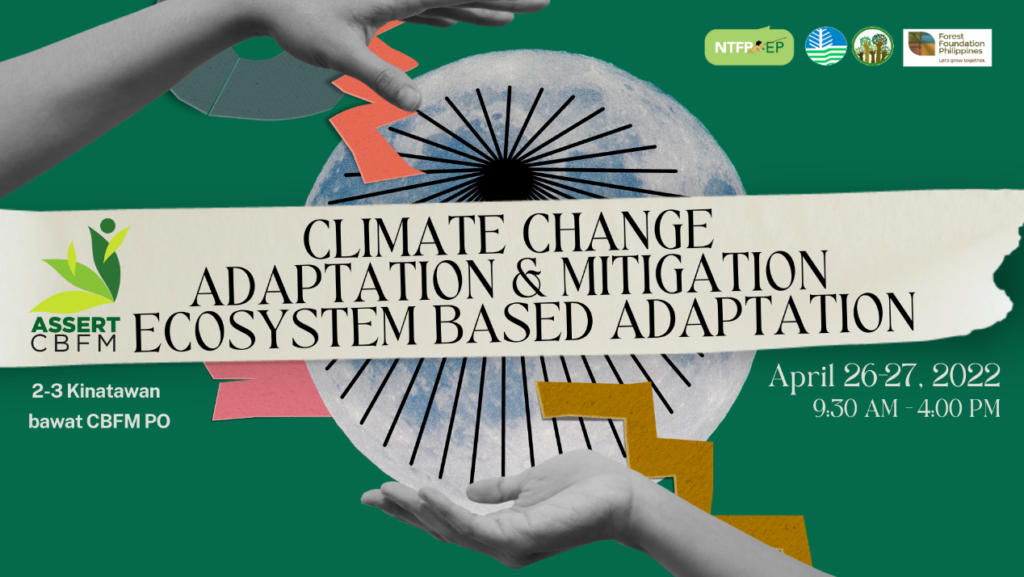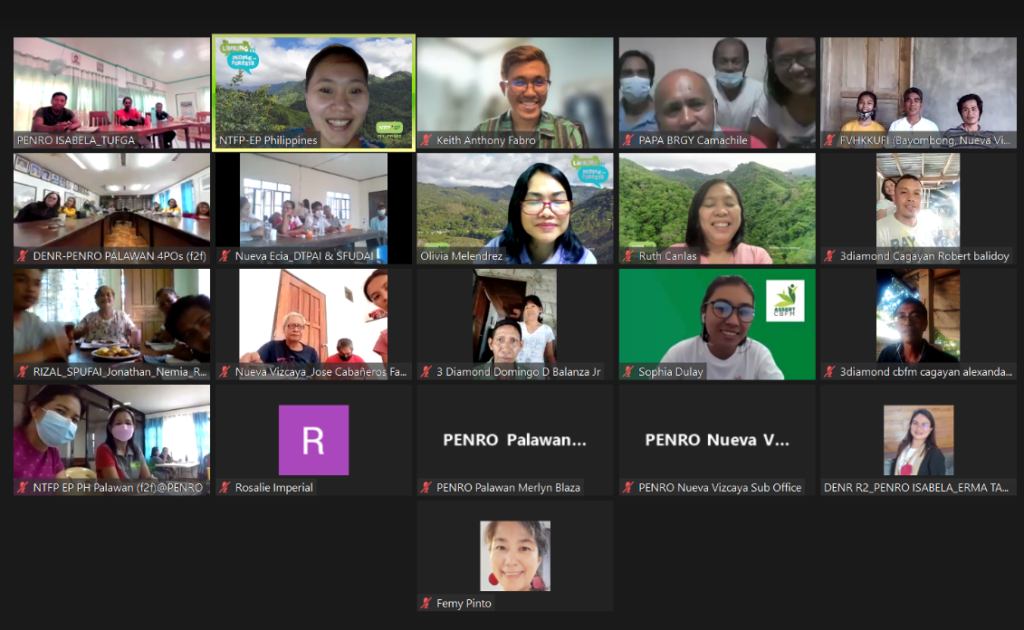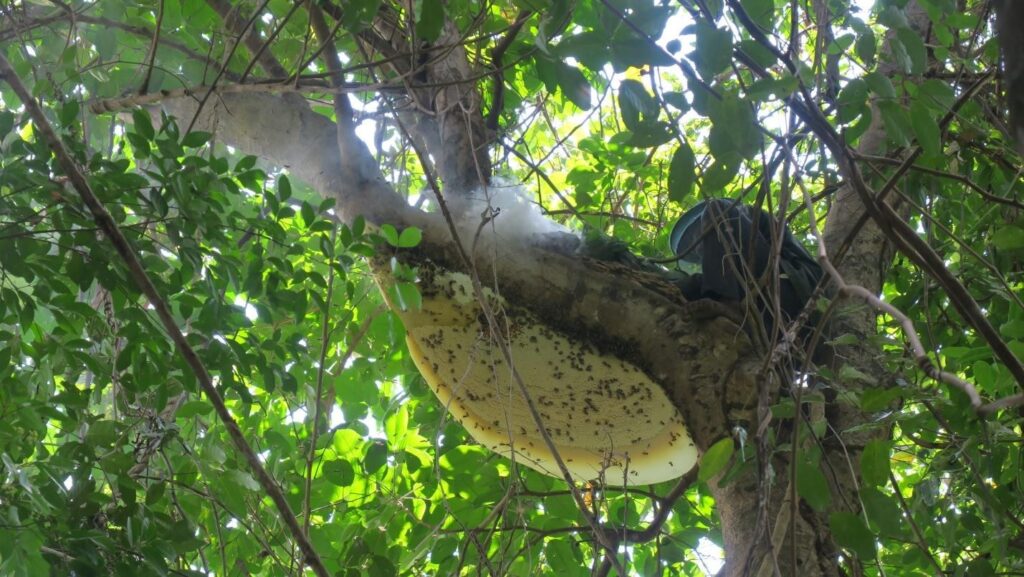
The ASSERT-CBFM Capacity Building Sessions launched an online training last 26 and 27 April 2022 on Climate Change Adaptation and Mitigation (CCAM) and Ecosystem-based Adaptation (EbA) to help forest-based communities build resilience against the effects of climate change through discussions on climate science and the role of forests in climate change mitigation.
A total of 55 participants (29 Male, 26 Female) from 12 Community-based Forest Management (CBFM) peoples organizations and local/regional DENR staff attended the online learning session. The CCAM course is foundational for succeeding modules for Sustainable Forest Management, whilst the EbA course aims to explain ecosystem services and integrate EbA concepts and quality standards in CBFM projects.

Dazzle Labapis, tenure rights and governance programme officer lead from NTFP-EP Asia, opened the session by introducing the objectives of the online training. He also emphasized how familiarization on CCAM strategies is paramount in building a foundational knowledge for sustainable management.
Jonathan John Maldupana, a Climate Reality Leader trained in the Philippines and the resource speaker for the CCAM session, did not mince words in pointing to the root cause of climate change.
“The world is certainly getting hotter and we are the cause,” Maldupana said.
Maldupana presented statistics showing 99% of the studies all agree that humans caused climate change. Because of the continued harmful actions of humans, sea level rise will not be avoided. The Philippines is especially vulnerable with 929 coastal municipalities exposed to sea level rise. In response, the Philippines has committed to 75% greenhouse gas reduction in accordance to the Paris Agreement in 2015.
“The care for forestry is one of the most important solutions to climate change,” Maldupana said.
The first day of the training also discussed indigenous knowledge, systems and practices (IKSPs) and how Indigenous Peoples and Local Communities (IPLCs) observe the behavior and changes in the surrounding nature using traditional knowledge passed down through generations. Olivia Melendrez, the Sierra Madre Landscape coordinator for NTFP-EP Philippines, shared how indigenous and local communities use IKSPs to determine if a typhoon is approaching such as using sightings of a bird called sawi in Mindanao, or observing a mother hen that won’t leave her chicks in the nest.
”There are published researches that links animal behavior with earthquakes,” Melendrez said.
Moreover, IKSPs play a role in CCAM strategies. The Mangyan people in Mindoro island adapt to effects of severe flood by sheltering under “libaog”, a traditional evacuation center. IPLCs also know which traditional crops would survive intense heat or severe rain through generational knowledge.
Ecosystem-based adaptation for the people
For the second day of the training course, Melendrez discussed how EbA uses biodiversity and the ecosystem to help communities adapt to the worsening effects of climate change. The main benefit of EbA is the conservation of ecosystems that builds resilience to climate change, while benefiting both humans and the environment.
“There must be multi-level policies for EbA to be ensured,” Melendrez said. EbA supports equal governance that empowers women and youth.
In the afternoon session, Keith Anthony Fabro presented the EbA approach to Macatumbalen Community Based Forest and Coastal Management Association (MCBFCMA), a community-based forest management PO based in San Vicente, Palawan. Fabro provided evidence of CBFM’s crucial contribution to the Philippines’ Nationally Determined Contribution (NDC). The result of the government’s National Greening Program and self-initiated reforestation efforts of the local community revived the denuded forest lands.
However, in 2021 Typhoon Odette caused extensive damage to the area’s forests which directly impacted the forest-based livelihoods and sustenance of the villagers. The typhoon survivors struggled as they had to restart their livelihoods from scratch. With limited funding and technical support, the MCBFCMA mobilized their people, from youth to elderly, to revamp their community nursery. They aimed to replant all the felled trees and vegetation beginning with the cultivation of seedlings native to their forest.
“The community [should not be] only dependent on forest-based livelihoods, in case the community will be hit by climate extremes, they can still have other livelihood sources,” Fabro said.
Input and reflections from the participants
While Nida Collado, leader of the MCBFCMA, disapproves of the presence of outsiders and squatters in and around their CBFM area, a representative from the provincial DENR of Palawan explained that illegal settlers and illegal loggers are a perennial problem.
“Sometimes these illegal settlers from far regions would claim the land for themselves by filing for land titles. Our forest lands are dwindling due to their activities and our hands are tied,” said the representative of DENR-PENRO Palawan. She promised however that the DENR would continue to fight against land grabbers and other unscrupulous individuals.
Collado said that the Bicolano or Cebuanos in their area are not squatters, because their local association have made them partners of CBFM. Even if the local community is not deputized, Collado says that the village is responsible for the protection of the forest and thus, they will continue to confiscate unpermitted chainsaws.
“I hope for the CBFM to be legislated at a national government level. I hope that the [University of the Philippines Los Baños] will be able to help in studying and researching CBFM,” Collado said.
Other POs from Nueva Vizcaya and Bulacan also expressed their wish to lobby the CBFM into legislation. They also raised their concerns on how environmental projects by the governments fail to reach CBFM areas.
As the session closed, Fabro gave his gratitude to the community that accommodated his stay during the study. The community’s income and patrolling of the area was affected by Typhoon Odette. He wished for support from LGU and the DENR so that the people can recover quickly. Fabro’s team deployed a drone in Macatumbalen and later published an article in the community’s experience on the international environmental news outlet Mongabay.
Before the final day of the training ended, Ruth Canlas, executive director of NTFP-EP Philippines, explained how the Business Model Canvas works and why it is important in securing funding. The ASSERT CBFM Call for Proposals was then opened for communities looking for funding their forest and ecosystem-based livelihood projects.
This capacity building and learning course was organized by NTFP-EP Asia, NTFP-EP Philippines, and DENR-FMB, as part of the ASSERT CBFM Project collective learning course. We thank the Forest Foundation Philippines for supporting this initiative.
Article written by Sophia Dulay, TRG intern for NTFP-EP Asia.





